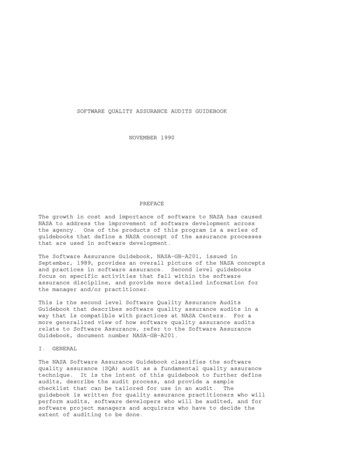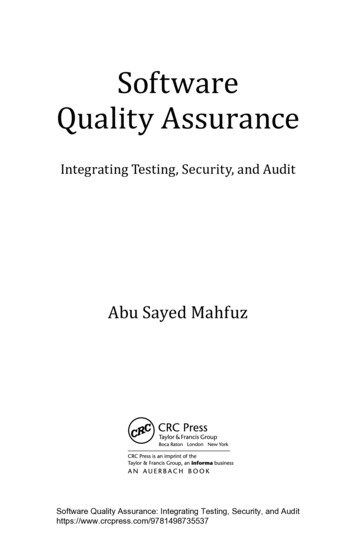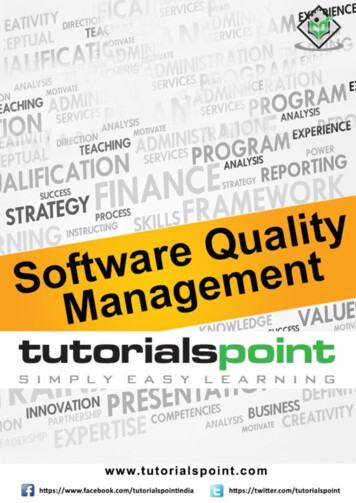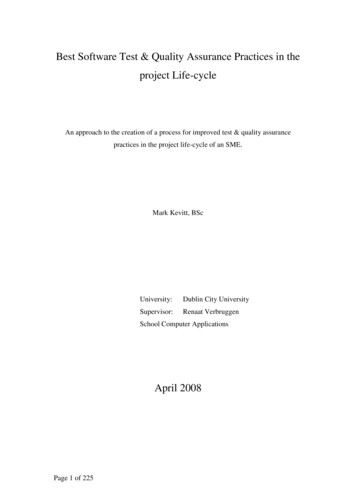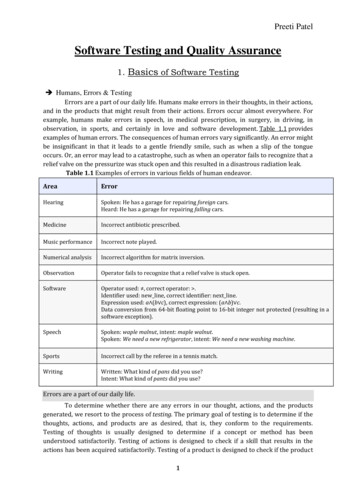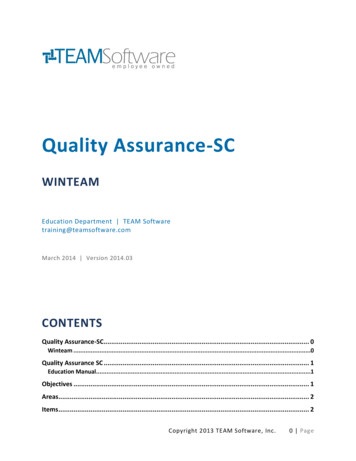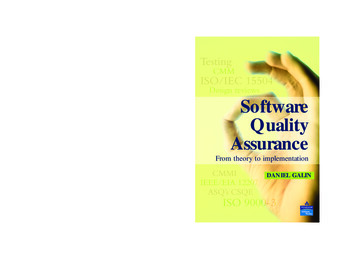
Transcription
Galin ppc21/9/058:51 PMPage 1CYAN MAGENTA YELLOW BLACKSoftware Quality AssuranceFrom theory to implementationDANIEL GALINThe book is a product of the author’s many years of consulting and teachingexperience.Features: A broad view of SQA. Discussion goes beyond classic custom-made software toinclude issues of in-house software development, outsourcing, and SQA in smallorganizations. Comprehensive discussion of practical issues. Stress is placed throughout onSQA application, operation, organization and control. Comprehensive coverage of SQA topics.Topics rarely covered in SQA texts areincluded: procedures and work instructions, supportive quality devices, costs ofsoftware quality and the actors participating in the SQA framework. State-of–the-art topics. Automated testing, computerized SQA tools and international standards (e.g., ISO 9000-3) are among the topics covered. Pedagogical support. Each chapter includes summary frames, case studies, real-lifeexamples and implementation tips, review questions and topics for discussion. On-line instructor’s guide.The guide contains lesson planning guidelines,PowerPoint presentations and a test bank.The book comprehensively covers the ISO 9000-3 requirements. It also provides asubstantial portion of the body of knowledge required for the CSQE (CertifiedSoftware Quality Engineer) as outlined by the ASQ (American Society for Quality).Dr Daniel Galin currently serves as Head of Information Systems Studies, theRuppin Academic Center. In addition to his many papers, Dr Galin has also authoredseveral books on the analysis and design of information systems as well as coauthoring (with Dr Z. Bluvband) a book on software quality assurance in Hebrew.His professional experience includes numerous consulting projects in software qualityassurance and information systems design for major Israeli firms. He received his BSc,MSc and DSc from the Faculty of Industrial and Management Engineering of theTechnion, Israel Institute of Technology, Haifa, Israel.Cover image Getty Imageswww.pearson-books.comSoftware QualityAssuranceSoftware quality assurance (SQA) is becoming increasingly important to the softwareand electronics industries as software systems become more complex and integrative.This book is designed to serve the three audiences who will be facing the SQAchallenge: students at universities and colleges, participants in vocational trainingcourses and software development and maintenance ceFrom theory to implementationDANIEL GALINGALIN
SQAS A01.QXD21/9/058:34 PMPage iSoftware Quality Assurance
SQAS A01.QXD21/9/058:34 PMPage iiWe work with leading authors to develop thestrongest educational materials in computing,bringing cutting-edge thinking and bestlearning practice to a global market.Under a range of well-known imprints, includingAddison Wesley, we craft high quality print andelectronic publications which help readers to understandand apply their content, whether studying or at work.To find out more about the complete range of ourpublishing, please visit us on the World Wide Web at:www.pearsoned.co.uk
SQAS A01.QXD21/9/058:34 PMPage iiiSoftware QualityAssuranceFrom theory to implementationDaniel Galin
SQAS A01.QXD21/9/058:34 PMPage ivPearson Education LimitedEdinburgh GateHarlowEssex CM20 2JEEnglandand Associated Companies around the worldVisit us on the World Wide Web at:www.pearsoned.co.ukFirst published 2004 Pearson Education Limited 2004The right of Daniel Galin to be identified as theauthor of this work has been asserted by him in accordancewith the Copyright, Designs, and Patents Act 1988.All rights reserved. No part of this publication may be reproduced, storedin a retrieval system, or transmitted in any form or by any means, electronic,mechanical, photocopying, recording, or otherwise without either the priorwritten permission of the Publishers or a licence permitting restricted copyingin the United Kingdom issued by the Copyright Licensing Agency Ltd,90 Tottenham Court Road, London W1T 4LP.All trademarks used herein are the property of their respective owners. The useof any trademark in this text does not vest in the author or publisher anytrademark ownership rights in such trademarks, nor does the use of suchtrademarks imply any affiliation with or endorsement of this book by such owners.ISBN 0201 70945 7British Library Cataloguing-in-Publication DataA catalogue record for this book is available from the British LibraryLibrary of Congress Cataloging-in-Publication DataGalin, Daniel,Software quality assurance / Daniel Galin.p. cm.Includes bibliographical references and index.ISBN 0-201-70945-71. Computer software--Quality control. I. Title.QA76.76.Q35G35 2003005.1'068'5--dc21200305066810 9 8 7 6 5 4 3 209 08 07 06 05Typeset in 10/12pt Sabon by 30.Printed and bound in Great Britain by Biddles Ltd, Guildford and King’s LynnThe publisher’s policy is to use paper manufactured from sustainable forests.
SQAS A01.QXD21/9/058:34 PMPage vTo my parents,Blima and Elchanan,who inspired me with their love of learning,scholarship, and teaching
SQAS A01.QXD21/9/058:34 PMPage vi
SQAS A01.QXD21/9/058:34 PMPage viiContentsPrefaceUnique features of this textThe book’s s acknowledgementsxxiAbout the authorxxiiGuides for special groups of readersGuide to readers interested in ISO 9000-3 requirementsGuide to readers interested in ASQ’S CSQE body of knowledgexxiiixxiiixxivPart I IntroductionChapter 1 The software quality challenge1.11.2The uniqueness of software quality assuranceThe environments for which SQA methodsare developedSummaryReview questionsTopics for discussionChapter 2 What is software quality?2.12.22.32.42.52.6What is software?Software errors, faults and failuresClassification of the causes of software errorsSoftware quality – definitionSoftware quality assurance – definition and objectivesSoftware quality assurance and software engineeringSummarySelected bibliographyReview questionsTopics for discussion13471112121415161924253030323233
SQAS A01.QXDviii21/9/058:34 PMPage viiiChapter 3 Software quality factorsContents3.13.23.33.43.53.63.73.8The need for comprehensive software qualityrequirementsClassifications of software requirements intosoftware quality factorsProduct operation software quality factorsProduct revision software quality factorsProduct transition software quality factorsAlternative models of software quality factorsWho is interested in the definition of qualityrequirements?Software compliance with quality factorsSummarySelected bibliographyReview questionsTopics for discussionChapter 4 The components of the software qualityassurance system – overview4.14.24.34.44.54.64.74.8The SQA system – an SQA architecturePre-project componentsSoftware project life cycle componentsInfrastructure components for error preventionand improvementManagement SQA componentsSQA standards, system certification, andassessment componentsOrganizing for SQA – the human componentsConsiderations guiding construction of anorganization’s SQA systemPart II Pre-project software quality componentsChapter 5 Contract review5.15.25.35.45.55.6Introduction: the CFV Project completioncelebrationThe contract review process and its stagesContract review objectivesImplementation of a contract reviewContract review subjectsContract reviews for internal 727577787980828585
SQAS A01.QXD21/9/058:34 PMPage ix87888989Chapter 6 Development and quality plans956.16.26.36.4Development plan and quality plan objectivesElements of the development planElements of the quality planDevelopment and quality plans for small projectsand for internal projectsSummarySelected bibliographyReview questionsTopics for discussionAppendix 6A: Software development risks andsoftware risk management92949797101103106108109110112Part III SQA components in the project life cycle 119Chapter 7 Integrating quality activities in theproject life cycle7.17.27.37.4Classic and other software developmentmethodologiesFactors affecting intensity of quality assuranceactivities in the development processVerification, validation and qualificationA model for SQA defect removal effectivenessand costSummarySelected bibliographyReview questionsTopics for discussionChapter 8 Reviews8.18.2Review objectivesFormal design reviews sSummarySelected bibliographyReview questionsTopics for discussionAppendix 5A: Proposal draft reviews –subjects checklistAppendix 5B: Contract draft review –subjects checklist
SQAS A01.QXDx21/9/058:34 PMContents8.38.48.5Page xPeer reviewsA comparison of the team review methodsExpert opinionsSummarySelected bibliographyReview questionsTopics for discussionAppendix 8A: DR report formAppendix 8B: Inspection session findings report formAppendix 8C: Inspection session summary reportChapter 9 Software testing – 76177178Definition and objectivesSoftware testing strategiesSoftware test classificationsWhite box testingBlack box testingSummarySelected bibliographyReview questionsTopics for discussion180182187189197209211212213Chapter 10 Software testing – implementation21610.110.210.310.4The testing processTest case designAutomated testingAlpha and beta site testing programsSummarySelected bibliographyReview questionsTopics for discussionChapter 11 Assuring the quality of softwaremaintenance components11.111.211.311.4IntroductionThe foundations of high qualityPre-maintenance software quality componentsMaintenance software quality assurance toolsSummarySelected bibliographyReview questionsTopics for 73275275277
SQAS A01.QXD21/9/058:34 PMPage xiChapter 12 Assuring the quality of externalparticipants’ contributions12.412.5Introduction: the HealthSoft caseTypes of external participantsRisks and benefits of introducing externalparticipantsAssuring quality of external participants’contributions: objectivesSQA tools for assuring the quality of externalparticipants’ contributionsSummarySelected bibliographyReview questionsTopics for discussionChapter 13 CASE tools and their effect on 95295296298What is a CASE tool?299The contribution of CASE tools to softwareproduct quality302The contribution of CASE tools to softwaremaintenance quality304The contribution of CASE tools to improved projectmanagement304Summary305Selected bibliography306Review questions306Topics for discussion307Part IV Software quality infrastructurecomponents309Chapter 14 Procedures and work instructions31114.114.214.314.4The need for procedures and work instructionsProcedures and procedures manualsWork instructions and work instruction manualsProcedures and work instructions: preparation,implementation and updatingSummarySelected bibliographyReview questionsTopics for discussionAppendix 14A: Design review .212.3xi279
SQAS A01.QXDxii21/9/058:34 PMPage xiiChapter 15 Supporting quality rySelected bibliographyReview questionsTopics for discussion326329332333333334Chapter 16 Staff training and .916.10Introduction: Surprises for the “3S”development teamThe objectives of training and certificationThe training and certification processDetermining professional knowledge requirementsDetermining training and updating needsPlanning training and updating programsDefining positions requiring certificationPlanning the certification processesDelivery of training and certification programsFollow-up subsequent to training and certificationSummarySelected bibliographyReview questionsTopics for discussionChapter 17 Corrective and preventive n: the “3S” development team revisitedCorrective and preventive actions – definitionsThe corrective and preventive actions processInformation collectionAnalysis of collected informationDevelopment of solutions and their implementationFollow-up of activitiesOrganizing for preventive and corrective actionsSummarySelected bibliographyReview questionsTopics for 47349350351352353354356359360361362362363
SQAS A01.QXD21/9/058:34 PMPage xiii18.118.218.318.418.518.618.7Software configuration, its items and its managementSoftware configuration management – tasks andorganizationSoftware change controlRelease of software configuration versionsProvision of SCM information servicesSoftware configuration management auditsComputerized tools for managing softwareconfigurationSummarySelected bibliographyReview questionsTopics for discussionChapter 19 Documentation control19.119.219.319.419.519.6Introduction: where is the documentation?Controlled documents and quality recordsThe controlled documents listControlled document preparationIssues of controlled document approvalIssues of controlled document storage and retrievalSummarySelected bibliographyReview questionsTopics for discussionPart V Management components of softwarequalityChapter 20 Project progress control20.120.220.320.4The components of project progress controlProgress control of internal projects and externalparticipants.Implementation of project progress control regimesComputerized tools for software progress controlSummarySelected bibliographyReview questionsTopic for discussion365xiii367ContentsChapter 18 Configuration 411
SQAS A01.QXDxiv21/9/058:34 PMPage xivChapter 21 Software quality metricsContents21.121.221.321.421.521.6Objectives of quality measurementClassification of software quality metricsProcess metricsProduct metricsImplementation of software quality metricsLimitations of software metricsSummarySelected bibliographyReview questionsTopics for discussionAppendix 21A: The function point methodChapter 22 Costs of software quality22.122.222.322.422.5Objectives of cost of software quality metricsThe classic model of cost of software qualityAn extended model for cost of software qualityApplication of a cost of software quality systemProblems in the application of cost of softwarequality metricsSummarySelected bibliographyReview questionsTopics for 50451455458462463465465468Part VI Standards, certification and assessment 471Chapter 23 Quality management standards23.123.223.323.423.523.6The scope of quality management standardsISO 9001 and ISO 9000-3Certification according to ISO 9000-3Capability Maturity Models – CMM and CMMIassessment methodologyThe Bootstrap methodologyThe SPICE project and the ISO/IEC 15504software process assessment standardSummarySelected bibliographyReview questionsTopics for discussionAppendix 23A: CMMI process areasAppendix 23B: ISO/IEC 15504 model processes475476477481485490492497499500501502505
SQAS A01.QXD21/9/058:34 PMPage xvChapter 24 SQA project process standards –IEEE software engineering standards24.224.324.4Structure and content of IEEE software engineeringstandardsIEEE/EIA Std 12207 – software life cycle processesIEEE Std 1012 – verification and validationIEEE Std 1028 – reviewsSummarySelected bibliographyReview questionsTopics for discussionAppendix 24A: IEEE Software Engineering StandardsAppendix 24B: MIL-STD-498: list of Data ItemDescriptions (DIDs)Appendix 24C: Task structure for a primary processaccording to IEEE/EIA Std 12207 – example509510514519521524524525526528528Part VII Organizing for quality assurance539Chapter 25 Management and its role in softwarequality assurance54325.125.225.3Top management’s quality assurance activitiesDepartment management responsibilities for qualityassuranceProject management responsibilities for qualityassuranceSummarySelected bibliographyReview questionsTopics for discussion544549550551552553554Chapter 26 The SQA unit and other actors in the SQAsystem55526.126.226.326.4The SQA unitSQA trustees and their tasksSQA committees and their tasksSQA forums – tasks and methods of operationSummaryReview questionsTopics for discussion556563563564565568568Contents24.1xv507
SQAS A01.QXDxvi21/9/058:34 PMPage xviEpilogue The future of SQA570ContentsFacing the future: SQA challengesFacing the future: SQA capabilities571574Author index577Subject index580
SQAS A01.QXD21/9/058:34 PMPage xviiPrefaceThe opening of the new Denver International Airport (DIA) in February1995 was a day of celebration for Colorado citizens but it was certainly theend of a traumatic period for the information technology industry. DIA wasplanned to be the largest airport in the United States, to serve 110 000 000passengers annually by 2020, to handle 1750 flights daily through 200 gatesand 12 operating runways. Operations at DIA were delayed by 16 months,mainly due to the failure of the software-based baggage handling system,causing estimated total losses of 2 billion. Moreover, the baggage handlingsystem finally put into service was substantially downscaled in comparisonto the system originally specified. Although several other colossal failures ofsoftware systems unfortunately have been recorded since 1995, the failure ofIT technology at DIA was especially traumatic to the profession, whetherdue to the scale of the losses or the public interest and criticism it raised.Many SQA professionals, including the author, believe that had appropriate software quality assurance systems been applied to the project at itsstart, a failure of this scale would not have occurred or, at least, its losseswould have been dramatically reduced. The methods and tools discussed inthis book, especially the risk management procedures, could have identifiedthe severity of the situation at very early stages and enabled timely employment of the appropriate corrective measures throughout the project. OtherSQA tools could probably have assured completion of the system on scheduleand in full compliance with its specifications.According to the author’s conception of software quality assurance, anacceptable level of software quality can be achieved by: Combined application of a great variety of SQA components.Special emphasis on quality in the early phases of software development,including the pre-project phase.Performance of comprehensive SQA activities to control the quality of thework carried out by external participants (subcontractors, suppliers ofreused software modules and COTS software products, and the customers themselves in cases where they carry out parts of the project).Extension of SQA activities to project schedules and budget control,based on the expectation that functional requirements, schedule andbudget plans behave according to the principle of communicating vessels,that is, a failure (or reduced level of achievement) in one of these threefluid components induces immediate failure in the others.This conception of software quality assurance guides us throughout the book.
SQAS A01.QXDxviii21/9/058:34 PMPage xviiiUnique features of this textPrefaceThe following features of this book are of special importance: A broad view of SQAComprehensive discussion of SQA implementation issuesComprehensive coverage of SQA topicsState-of-the-art topics.A detailed discussion of these features follows.A broad view of SQAThe book extends discussion of SQA issues much beyond the classic boundaries of custom-made software development by large established softwarehouses. It dedicates significant attention to the other software developmentand maintenance environments that reflect the current state of the industry: In-house software development by information systems departments. Thebook discusses SQA of in-house projects, situations where traditionalcustomer–supplier relations are missing or vague, and outlines recommended solutions to the attendant risks (see Sections 5.6 and 6.4.2).COTS software packages. COTS software packages represent a growingproportion of software packages used throughout the industry. Assuranceof the quality of these packages, which are integrated directly into the customer’s software systems, has become an important issue (see Chapter 12).Small projects and small organizations. Issues related to software development by small organizations and the execution of small softwareprojects are likewise dealt with in the book (see Section 6.4.1).Comprehensive discussion of SQA implementation issuesStress is placed throughout the book on organization, control and otheraspects arising in the implementation of SQA components: Specialized chapter sections and subsections dealing with implementationprocesses.Examples that refer to real-life situations, especially those involvingimplementation issues, are integrated into the text.Implementation tips related to special implementation problems are integrated into most of the chapters.Topics for discussion, found at the conclusion of each chapter, encouragethe reader to suggest innovative solutions to implementation issues.Comprehensive coverage of SQA topicsThe book is very comprehensive in the range of SQA subjects covered. Itincludes topics rarely if ever covered in other SQA texts. These topics include:
SQAS A01.QXD 8:34 PMPage xixProcedures and work instructions, their preparation, implementation andupdating (Chapter14).Supporting quality devices, that is, templates and checklists, their preparation, implementation and updating (Chapter 15).Costs of software quality, estimated according to the classic quality costsmodel in addition to a new extended model that better represents the special nature of software quality costs (Chapter 22).The SQA unit and other actors in the SQA framework, specifically theactivities and responsibilities of active and occasional bodies that promote SQA issues within the organization: the SQA unit, SQA trustees,SQA committees and SQA forums (Chapter 26).State-of–the-art topicsThe text emphasizes up-to-date SQA topics: Automated testing, including a discussion of the various types of automated tests and their implementation, concluding with a review of theadvantages and disadvantages of automated testing (Section 10.3).Computerized SQA tools, discussed in conjunction with almost all SQAcomponents mentioned in the book. A special chapter (Chapter 13),entirely dedicated to computerized tools, reviews CASE tool issues.Special emphasis is placed on techniques that dramatically improve theperformance of SQA tools, such as automated testing, software configuration management and documentation control.International SQA standards. Two chapters (Chapters 23 and 24) arededicated to a survey of recent developments in software quality management standards and project process standards.A downloadable Instructor’s Guide, PowerPoint Slides and additional testing material are also available free of charge to lecturers and tutors adoptingthe main book. They can be accessed at www.booksites.net/galin.The book’s audienceThe book is intended to meet the needs of a wide audience of readers interested in software quality assurance. We can identify four main groups ofsuch readers, as follows: Managers of software development departments, project managersand othersThose attending or presenting vocational training coursesUniversity and college studentsPractitioners involved in quality issues of software development andmaintenance.In addition, there are special groups of readers who are addressed on pagexxiii.xixPreface 21/9/05
SQAS A01.QXD21/9/058:34 PMPage xxAcknowledgementsThis book has benefited from comments by software consumers as well asquestions from students in the many courses I have taught at the Technion,Israel Institute of Technology, the Ruppin Academic Center and elsewhere.They helped me improve my explanations and inspired many of my examples. Others helped by directly answering questions or supplying valuablearticles, books and other material. Their numbers prevent my mentioning alltheir names. I am grateful to each.Special thanks to Andrea Shustarich, representative of PearsonEducation in Israel, who encouraged me to write this book and followed itsprogress. My editor, Keith Mansfield, a senior acquisition editor at PearsonEducation in the UK, also deserves special recognition for his cooperation,continuous guidance and valuable advice throughout the long months ofwriting. I would especially like to express my appreciation to NicolaChilvers, responsible for production of this book at Pearson Education,whose efficiency and amiable manner made working together such pleasure.In addition, I wish to express my appreciation to Nina Reshef, who editedmy drafts with devotion and contributed substantially to the book’s readability and accuracy.Finally, I wish to say how grateful I am to my family, my wife AmiraGalin, my daughter Michal Nisanson and my son Yoav Galin for their continuous support and encouragement as well as for their important commentson the book’s drafts.
SQAS A01.QXD21/9/058:34 PMPage xxiPublisher’s acknowledgementsWe are grateful to the following for permission to reproduce copyright material:Figure 7.1 adapted from Royce, W.W. (1970) Managing the Development oflarge Software Systems: Concepts and Techniques, Proceedings of the IEEEWESCON, August 1970 and Software Engineering Economics by Boehm,B.W. 1981. Reprinted by permission of Pearson Education, Inc., UpperSaddle River, NJ. Figure 7.3 adapted from Boehm, B.W. (1988) A SpiralModel of Software Development and Enhancement, Computer, Vol. 21, No.5, pp. 61–72; Figure 7.4 adapted from Boehm, B.W. (1998) Using the WinWin Spiral Model: A case study, Computer, Vol. 31, No. 7, pp. 33–44; Table8.3 and Table 21.11 from Japan’s Software Factories: A Challenge to U.S.Management by Michael A. Cusumano, copyright 1991 by OxfordUniversity Press, Inc. Used by permission of Oxford University Press, Inc.;Table 10.6 adapted from Dustin/Rashka/Paul, Automated Software Testing:Introduction, Management and Performance, Table 2.4 (p. 53), PearsonEducation, Inc. Reprinted by permission of Pearson Education, Inc.; Table23.1 and Table 23.2 reproduced with the permission of BSI under licence no.2003SK/0025. British Standards can be obtained from BSI CustomerServices, 389 Chiswick High Road, London W4 4AL (Tel. 44 (0) 208 9969001). Figure 23.2 Capacity Maturity Model by Paulk et al. Reprinted bypermission of Pearson Education, Inc., Upper Saddle River, NJ. Table 23.5and 23.6 adapted from Jung, H.-W., Hunter, R., Goldenson, D.R. and ElEman, K. (2001) Finding the Phase 2 of the SPICE Trials, Software ProcessImprovement and Practice, 7(6) pp. 205–42. John Wiley & Sons Limited.Reproduced with permission. Figure 24.1 reprinted with permission fromIEE Std 1045-19992 by IEEE. The IEEE disclaims any responsibility or liability resulting from the placement and use in the described manner.BSI for the eight principles of ISO 9000.3 and the structure of the ISO/IECTR 15504 Standard (under licence number 2003DH0143), and IEEE forIEEE Std. 10278 (reviews) 1994 IEEE and list of IEEE SoftwareEngineering Standards.In some instances we have been unable to trace the owners of copyrightmaterial, and we would appreciate any information that would enable us todo so.
SQAS A01.QXD21/9/058:34 PMPage xxiiAbout the authorDr Daniel Galin received his B.Sc. in Industrial and ManagementEngineering, and his M.Sc. and D.Sc. in Operations Research from theFaculty of Industrial and Management Engineering, the Technion, IsraelInstitute of Technology, Haifa, Israel. He serves on the faculty of the RuppinAcademic Center, where he is the current Head of Information SystemsStudies.Dr Galin acquired his expertise in SQA through teaching, writing andconsulting in the field. He teaches courses in software quality assurance andinformation systems at the Ruppin Academic Center, Information SystemsStudies, at the Faculty of Computer Sciences, the Technion, Haifa and at theCollege of Administration, Tel-Aviv.Dr Galin co-authored (with Dr Z. Bluvband) the book Software QualityAssurance. His many papers have been published in professional journals,the majority in English-language journals. All his former books on analysisand design of information systems and software quality assurance were writtenin Hebrew and published by Israel’s leading publishers.Dr Galin’s professional experience of over 20 years includes consultingon numerous projects in software quality assurance as well as analysis anddesign of information systems.
SQAS A01.QXD21/9/058:34 PMPage xxiiiGuides for special groupsof readersAmong the readers interested in software quality assurance, one can distinguish two special groups: Readers interested in ISO 9000-3 requirementsReaders interested in the American Society for Quality’s (ASQ) CSQE(Certified Software Quality Engineer) body of knowledge.The following tables direct the reader to the chapters and sections relevantto their interests.Guide to readers interested in ISO 9000-3 requirementsThe reader interested in ISO 9000-3 requirements will find a comprehensivediscussion of standard ISO issues in Chapter 23. In addition, related material is spread throughout the book, as detailed in the following table. The ISO9000-3 requirements numbers quoted are taken from the outline of ISO/IEC9000-3:2001 (final draft).ISO 9000-3requirements:chapterISO 9000-3 requirements:subjectBook references(chapter/section)4. Qualitymanagementsystem4.1 General requirements4.2 Documentation requirementsCh. 4Ch. 195. Managementresponsibilities5.1 Management commitments5.2 Customer focus5.3 Quality policy5.4 Planning5.5 Responsibility authority and communication5.6 Management reviewSec. 25.1Sec. 25.1.1Sec. 25.1.1Ch. 25Ch. 25Sec. 25.1.36. Resourcemanagement6.1 Provision of resources6.2 Human resource
Chapter 11 Assuring the quality of software maintenance components 254 11.1 Introduction 255 11.2 The foundations of high quality 257 11.3 Pre-maintenance software quality components 261 11.4 Maintenance software quality assurance tools 264 Summary 273 Selected bibliography 275 R

